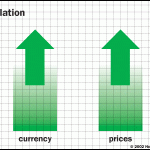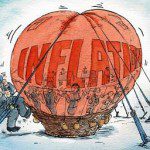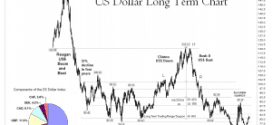In the coming years, Europe appears set to lurch from the frying pan of depression to the fire of high inflation. When it does, the lessons of the Great Inflation [outlined in this article] will suddenly be all too pertinent.
to the fire of high inflation. When it does, the lessons of the Great Inflation [outlined in this article] will suddenly be all too pertinent.
So writes Brigitte Granville in edited excerpts from her article* entitled The Ghost Of Inflation Future.
[The following article is presented by Lorimer Wilson, editor of www.FinancialArticleSummariesToday.com and www.munKNEE.com and the FREE Market Intelligence Report newsletter (sample here – register here) and may have been edited ([ ]), abridged (…) and/or reformatted (some sub-titles and bold/italics emphases) for the sake of clarity and brevity to ensure a fast and easy read. This paragraph must be included in any article re-posting to avoid copyright infringement.]
Granville goes on to say in further edited (and perhaps paraphrased in some instances) excerpts:
With all of the problems afflicting the world economy nowadays, inflation seems to be the least of our worries…but dismissing inflation as “yesterday’s problem” could undermine central banks’ efforts to address today’s most pressing issues and, ultimately, facilitate inflation’s resurgence.
[This article provides a greater] understanding of how the Great Inflation from the late 1960’s to the early 1980’s was tamed and offers important lessons for addressing far-reaching economic problems, however different ours may be, and provides insight into the dangers that may lie ahead.
The first useful lesson concerns expectations.
In the decades following World War II, the doctrine that inflation needed to be traded off against employment, based on the relationship that William Phillips described in 1958 [see here], dominated economic thinking but the Phillips curve fared poorly in the 1970’s, when many countries experienced “stagflation” (high levels of both inflation and unemployment).
- if people do not expect inflation then the illusion of increased purchasing power can boost employment and output for a relatively short period
- but once workers realize that real wages have not increased, unemployment will return to its “natural” level consistent with stable inflation.
Later, “new classical” economists like Robert Lucas and Thomas Sargent demonstrated that once people understand that inflation is being manipulated to generate market optimism, the monetary authorities’ actions lose their impact. The result is higher prices and no job creation.
[The above]…ideas, combined with effective policy practice like that of the US Federal Reserve under Paul Volcker’s chairmanship, led many countries worldwide toward more explicit inflation targeting, in which central banks stabilize inflation expectations by making a credible commitment to a predetermined rate of price growth. By the 1990’s, inflation was old news in the advanced economies, with much of the developing world soon to follow.The Fed is again playing the expectations game but, in order to stave off the threat of deflation and depression, it is targeting a lower unemployment rate, below 6.5%. [With] progress [being made] toward the target…
- Fed Chairman Ben Bernanke announced in late May that the Fed will begin to “taper” its program of long-term asset purchases known as quantitative-easing (QE)…sparking renewed financial-market volatility.
- In July, Bernanke attempted to calm investors with remarks signaling that, amid inadequate employment gains and persistently low inflation, the Fed would not abandon monetary stimulus anytime soon…
reflecting the Fed’s dual mandate, according to which monetary policy targets maximum employment consistent with price stability.
The credibility needed to anchor expectations, however, is difficult – sometimes even impossible – to achieve when two targets are being pursued simultaneously.
- The resulting uncertainty could trigger more volatility, especially in bond markets, potentially impeding economic recovery (for example, by pushing up long-term mortgage rates) or augmenting future inflation risk.
- The credibility associated with pursuing only an inflation target, however, builds on itself.
Given the above, it would be safer and more effective for the Fed and other central banks to pursue a single inflation target, and then use the gain in credibility to aid economic recovery. For example, a central bank might announce that circumstances during, say, the next two years warrant a doubling of the inflation target from the usual – that is, almost never varied – annual rate of 2%. Such an approach would reduce the risk of debt deflation, while capping inflation expectations to prevent a damaging surge in prices as recovery takes hold.
The second relevant lesson is that fiscal discipline is essential to price stability.
…Sustaining a high budget deficit over many years will lead to an unmanageable debt buildup, unless that debt is inflated away or restructured. As it stands, the United States – and presumably the United Kingdom – plans to begin tapering QE when:
- the economy is growing faster,
- unemployment is lower, and
- government and household revenues are rising,
but will tax revenues rise fast enough to offset the escalating cost of servicing the government’s mountain of debt? Even if public debt is not growing as fast as before, the huge volume of existing debt must be repaid.
The best cure would be controlled higher inflation – that is, the aforementioned temporary increase in the inflation target – to erode the real value of public debt and forestall the risk of a much more damaging inflationary shock later, one in which expectations become unhinged.
While the above approach could work in the U.S., the European Central Bank is institutionally constrained from raising the inflation target. Although its pledge last August to purchase unlimited quantities of short-term government debt has calmed markets, activation of the ECB’s “outright monetary transactions” program is conditional on continued fiscal retrenchment so the eurozone’s crisis-stricken economies cannot grow. In this context, the eurozone’s most heavily indebted countries will have to force their creditors to accept a restructuring of public debt. The preferable alternative would be growth-boosting devaluations – that is, a eurozone breakup – but if, as seems likely, such devaluations are left too late, debt restructuring might still be needed.
Conclusion
In the coming years, Europe appears set to lurch from the frying pan of depression to the fire of high inflation. When it does, the lessons of the Great Inflation will suddenly be all too pertinent.
[Editor’s Note: The author’s views and conclusions in the above article are unaltered and no personal comments have been included to maintain the integrity of the original post. Furthermore, the views, conclusions and any recommendations offered in this article are not to be construed as an endorsement of such by the editor.]
*http://www.advisoranalyst.com/glablog/2013/08/12/guest-post-the-ghost-of-inflation-future.html (AdvisorAnalyst.com®, Copyright © 2007-2013, AdvisorAnalyst Views, Some Rights Reserved) Original Source: http://www.project-syndicate.org/print/the-great-inflation-s-lessons-for-central-banks-by-brigitte-granville (Brigitte Granville is Professor of International Economics and Economic Policy at the School of Business and Management, Queen Mary, University of London, and the author of Remembering Inflation.)
Related Articles:
1. Ignore the Hype: Inflation Is NOT That High – Anywhere!
There is very little evidence of high inflation at present, despite what the hyperinflationists say, and a little bit of common sense totally debunks the idea that there is. Read More »
With stocks at record highs and the U.S. economy improving, the European debt crisis seems like a distant memory….[While] Europe is no longer the market’s focal point, however, that doesn’t mean the euro zone’s financial problems have gone away. Read More »
3. Rapidly Rising Interest Rates Could Lead to Financial Collapse – Here’s Why
The global financial system is potentially heading for massive amounts of trouble if interest rates continue to soar. So what does all this mean exactly? [Let me explain.] Read More »
4. 4 Main Macro Issues Are Shaping the Investment Climate – Here’s An Update
There are four main macro issues shaping the investment climate: 1.the tapering anticipation in the U.S.; 2.the stabilization of the Chinese economy; 3.a cyclical recovery in Europe and 4. the long awaited Japanese purchases of foreign bonds. Read More »
 munKNEE.com Your Key to Making Money
munKNEE.com Your Key to Making Money






Oh What a World, What a World…
– Wicked Witch, as she melted in the Wizard of OZ
YOU SHOULD KNOW THAT THE INFLATION OF THE 60’S TO LATE 80’S ,GOING OFF OF THE GOLD AND ON TO THE DOLLAR RESREVE .LOOK AT 73 AND 74 DOLLAR SUPPLY INCREASED BY 93%.